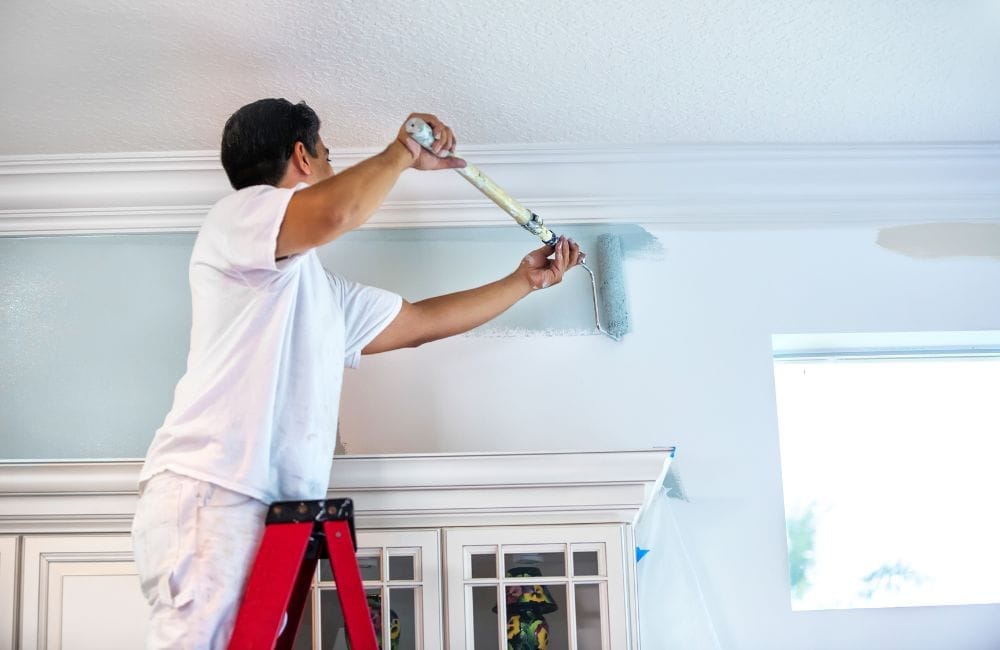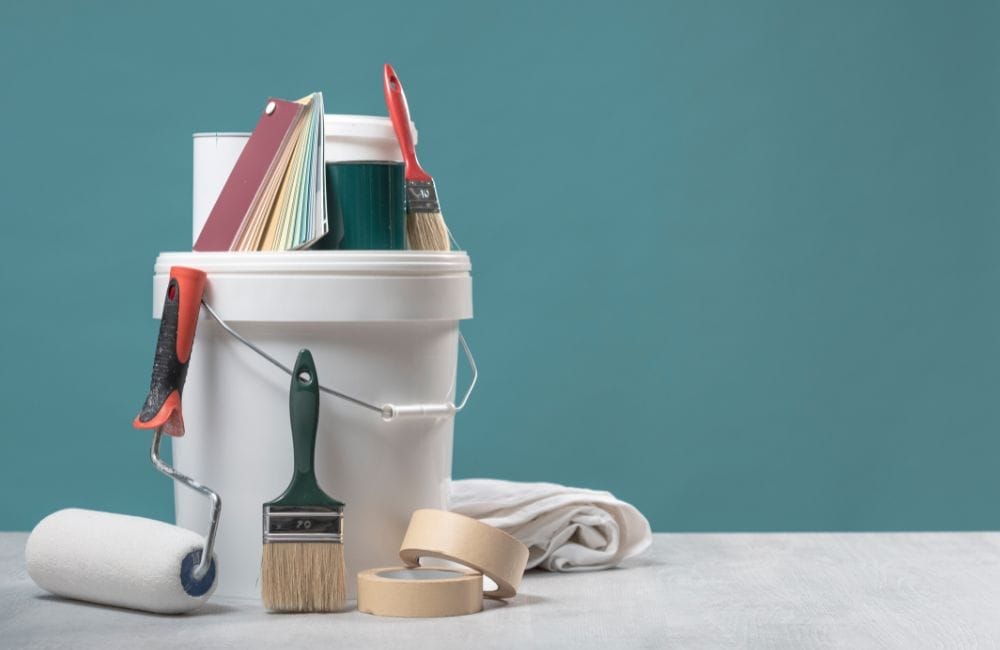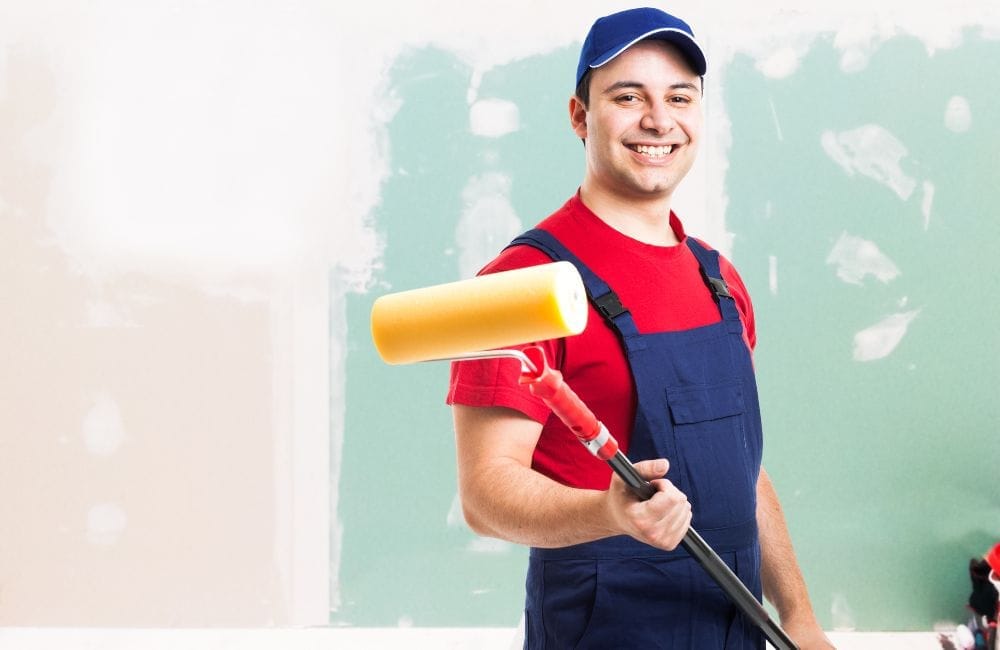
Table of Contents
Key Takeaways✔ Increase ventilation by opening windows or using fans to promote faster paint drying. ✔ Maintain a steady room temperature between 60-80°F to help paint dry more evenly and quickly. ✔ Use a dehumidifier in high-humidity areas to reduce moisture and accelerate the drying process. ✔ Apply multiple thin coats of paint rather than one thick layer to ensure faster drying and a smoother finish. ✔ Opt for fast-drying or low-VOC paints to speed up drying time while minimizing fumes for a healthier environment. |
For interior painting projects in West Hartford, CT, time is a crucial factor, and experienced house painters know several effective methods to speed up paint drying without compromising on the final result. Whether working on a tight schedule or aiming for efficiency, professionals rely on these five techniques to ensure that paint dries faster. These strategies not only save time but also improve the overall quality of the paint job, making them invaluable for any painting project.
1. Increase Ventilation
One of the most effective ways to speed up the drying process of interior paints is by increasing ventilation. Experienced house painters understand that proper airflow ensures paint dries quickly and evenly. By promoting circulation in the room, moisture from the wet paint evaporates faster, allowing the surface to set more quickly.
How Airflow Helps Dry Paint Faster
When fresh air moves through a space, it carries away moisture and brings in dry air, which accelerates the drying process. In closed or poorly ventilated rooms, paint remains wet for longer periods because the moisture is trapped.
Open Windows and Doors
House painters often recommend allowing fresh air to circulate freely throughout the room to create a natural exchange of humid and dry air. This promotes faster evaporation of paint moisture.
- Windows: Open all windows, especially those opposite each other, to create a cross-breeze that improves airflow.
- Doors: Leave doors open to enable better circulation between rooms, particularly when working in confined spaces.
Use Fans Strategically
While natural ventilation from open windows and doors can be helpful, house painters know that using fans can further enhance airflow, especially in areas where the air might be stagnant.
- Ceiling Fans: Turn on ceiling fans at a moderate speed to keep the air moving without creating strong gusts that could disturb the paint surface.
- Portable Fans: Position portable fans at key points in the room to direct airflow over freshly painted surfaces. Focus the fans on corners or sections of the room that don’t receive much air from natural ventilation.
- Exhaust Fans: If painting in rooms like kitchens or bathrooms, using exhaust fans to draw out moist air can help reduce humidity and improve drying times.

2. Control Room Temperature
When it comes to speeding up the drying process of interior paints, controlling the room temperature is one of the key strategies used by house painters. Temperature can directly influence how fast or slow paint dries, and managing it properly ensures a smoother finish without compromising quality.
Ideal Temperature Range for Paint Drying
The optimal temperature for drying interior paint is between 50-80°F (10-27°C). This range allows paint to dry evenly without causing the surface to crack or bubble. If the temperature is too low, the paint can take much longer to dry, resulting in a sluggish project timeline. On the other hand, if the room is too hot, the paint may dry too quickly, leading to uneven textures.
Using Heaters to Maintain a Warm Environment
In cooler climates or colder seasons, house painters often use heaters to keep the room within the ideal temperature range. A portable space heater or HVAC system can be used to warm up the area where the painting is being done.
How to use heaters effectively:
- Place Heaters Strategically: Keep them away from walls to prevent concentrated heat directly on the paint.
- Maintain a Steady Temperature: Avoid sudden temperature fluctuations to prevent the paint from drying unevenly. It’s essential to distribute the heat evenly throughout the space, so no part of the room gets overly warm or stays too cool. P
- Monitor the Heat: Use a thermostat to ensure the room stays between 60-80°F.
- Place Heaters Strategically: Keep them away from walls to prevent concentrated heat directly on the paint.
Avoid Extreme Heat to Prevent Uneven Drying
While heat is necessary to speed up drying, it’s equally important to avoid excessive temperatures. House painters advise against using high heat or blow dryers directly on the paint, as this can cause the surface to dry too quickly, leading to the following:
- Cracking: When paint dries too fast, the top layer hardens before the underneath is dry, causing cracks.
- Bubbling: Trapped moisture can rise to the surface, forming bubbles in the paint.
- Inconsistent Texture: The surface may become patchy if certain areas dry faster than others.
- Cracking: When paint dries too fast, the top layer hardens before the underneath is dry, causing cracks.
3. Use Dehumidifiers
One of the lesser-known factors that can significantly affect the time it takes for paint to dry is humidity. When humidity levels are high, the moisture in the air slows down the evaporation of water or solvents in the paint, which extends the drying time. This is why house painters often recommend using a dehumidifier during painting projects.
How Dehumidifiers Work
Dehumidifiers are designed to extract moisture from the air, lowering the humidity in a room. By reducing the moisture content in the air, they help speed up the evaporation process, which is crucial for quicker drying times. Professional house painters often turn to dehumidifiers as a reliable tool to keep the painting environment optimal.
When to Use a Dehumidifier
House painters find dehumidifiers particularly useful in the following situations:
- Humid Climates: In regions with high humidity levels, the air is naturally heavy with moisture. Dehumidifiers can keep the indoor space drier, ensuring that paint dries at a faster rate.
- Rainy or Wet Seasons: During the rainy season, moisture levels tend to rise, even indoors. House painters know that using a dehumidifier during this time can prevent extended drying times caused by excess moisture in the air.
- Basements and Other Damp Areas: Rooms like basements or areas prone to dampness can make paint dry much slower. Using a dehumidifier in these spaces helps mitigate this issue, ensuring a smoother painting process.
- Humid Climates: In regions with high humidity levels, the air is naturally heavy with moisture. Dehumidifiers can keep the indoor space drier, ensuring that paint dries at a faster rate.
Best Practices for Using a Dehumidifier
To maximize the benefits of a dehumidifier, house painters often follow these tips:
- Place the Dehumidifier in the Center of the Room: Position the dehumidifier centrally to ensure even moisture removal across the space. This helps all areas of the painted surface dry evenly.
- Close Windows and Doors: For maximum efficiency, close all windows and doors to prevent humid air from re-entering the room. This keeps the drying environment controlled.
Monitor Humidity Levels: House painters often recommend using a hygrometer to monitor humidity levels. Aim for a range of 40-50% humidity, as this is considered optimal for paint drying.
- Place the Dehumidifier in the Center of the Room: Position the dehumidifier centrally to ensure even moisture removal across the space. This helps all areas of the painted surface dry evenly.

4. Apply Thin Coats of Paint
When it comes to efficient and professional painting, house painters understand that applying thin coats of paint is a key factor in speeding up the drying process.
Benefits of Applying Thin Coats of Paint
House painters recognize several benefits when they apply paint in thin, even layers. The advantages go beyond just faster drying times:
- Faster Drying: Thin coats of paint dry significantly faster compared to thick layers. The reason for this is simple: less paint means less moisture, which allows the paint to evaporate and set more quickly. This is especially helpful when multiple layers are required to achieve full coverage.
- Even Coverage: Thin coats ensure that the paint is applied evenly across the surface. Thick coats are more prone to uneven application, resulting in streaks, drips, or an inconsistent finish. House painters know that a well-applied thin layer provides a more professional and polished result.
- Less Risk of Imperfections: When paint is applied too thickly, it can lead to common problems such as bubbling, cracking, or peeling. By applying thin coats, house painters reduce the risk of these imperfections, ensuring the paint adheres properly to the surface.
- Faster Drying: Thin coats of paint dry significantly faster compared to thick layers. The reason for this is simple: less paint means less moisture, which allows the paint to evaporate and set more quickly. This is especially helpful when multiple layers are required to achieve full coverage.
Steps to Apply Thin Coats Like a Professional
Applying thin coats of paint is a technique that professional house painters swear by for achieving smooth, even finishes with faster drying times. Here’s how they apply thin coats like a pro for the best results.
- Use the Right Tools: Professional house painters always use high-quality brushes and rollers designed for the specific type of paint they are applying. This ensures the paint spreads evenly and smoothly, creating a uniform, thin coat every time.
- Apply with Patience: One of the secrets house painters rely on is patience. They take the time to apply the paint methodically and avoid rushing through the process. Applying a thin coat requires controlled and steady strokes to ensure the paint doesn’t build up in certain areas.
- Allow Each Coat to Dry Fully: The most important part of the process is allowing each coat to dry completely before applying the next one. House painters know that impatience can lead to problems later on, as applying a second coat too soon can cause the paint to smudge, peel, or remain tacky. It’s best to follow the recommended drying time for the specific type of paint being used.
- Repeat the Process: For the best results, house painters often apply multiple thin coats rather than one thick layer. Each coat contributes to the overall finish and durability of the painted surface. Depending on the color and texture, it may take two to three coats to achieve the desired look.
- Use the Right Tools: Professional house painters always use high-quality brushes and rollers designed for the specific type of paint they are applying. This ensures the paint spreads evenly and smoothly, creating a uniform, thin coat every time.
5. Choose Fast-Drying Paints
When tackling an interior paint job, house painters know that the type of paint used can significantly impact the drying time. Some paints are specifically formulated to dry faster, making them ideal for projects that require quick turnaround times.
Paint Type | Description | Benefits | Use Case |
Latex Paints | Water-based paints known for quick drying times. | Dries to the touch within an hour, easy to clean with water, allowing faster application of coats. | Ideal for living rooms, bedrooms, and indoor spaces needing a quick refresh. |
Acrylic Paints | Water-based but with more acrylic resins, making them more durable. | Dries quickly, resists cracking and peeling, offers excellent durability. | Perfect for high-traffic areas like hallways and kitchens where durability and fast drying are key. |
Advantages of Low-VOC Paints
House painters often recommend low-VOC (volatile organic compounds) paints for interior jobs. These products are designed to release fewer chemicals into the air as they dry, making them safer for indoor use and healthier for the environment.
- Quick Drying: Many low-VOC paints dry just as fast, if not faster, than traditional paints. They contain fewer chemicals that inhibit drying, allowing house painters to complete projects efficiently.
- Health Benefits: Low-VOC paints emit fewer harmful fumes, reducing the risk of headaches, dizziness, or respiratory issues that can result from prolonged exposure to traditional paints.
- Eco-Friendly: These paints are an environmentally conscious choice, as they reduce the overall chemical footprint of the painting process.
- Quick Drying: Many low-VOC paints dry just as fast, if not faster, than traditional paints. They contain fewer chemicals that inhibit drying, allowing house painters to complete projects efficiently.
When to Choose Fast-Drying Paints
For house painters, choosing fast-drying paints is a smart decision when:
- Time is a Factor: When completing a project under a tight deadline, fast-drying paints allow for quicker application of multiple coats, reducing the overall time spent on the job.
- Occupied Spaces: Fast-drying paints are ideal for homes where residents are still living in the space, as they minimize disruption and reduce lingering odors.
- Climate Conditions: In humid or cold environments, slow-drying paints can take longer than expected to set. Opting for fast-drying formulas helps mitigate this challenge.
- Time is a Factor: When completing a project under a tight deadline, fast-drying paints allow for quicker application of multiple coats, reducing the overall time spent on the job.
Post that you may also like:
5 Reasons Your Business Needs Commercial Painting Maintenance
Frequently Asked Questions
What happens if I apply a second coat before the first coat dries?
Applying a second coat too soon can result in several issues. The paint may peel, crack, or develop an uneven texture, as the first layer hasn’t fully adhered or hardened. Additionally, wet paint underneath can cause the top layer to smudge, bubble, or even lift off the surface. This also increases the risk of streaks and roller marks becoming permanent. It’s crucial to allow enough drying time between coats, as outlined in the paint manufacturer’s instructions. If you notice any of these problems after prematurely adding a second coat, light sanding and reapplication may be necessary.
Why does paint sometimes feel sticky after drying?
Sticky paint is usually a sign that it hasn’t fully cured or dried properly. This often happens in high-humidity environments, where moisture interferes with the evaporation process. It can also occur if the paint was applied too thickly, or if the paint is old and its chemical composition has degraded. Sticky paint may also result from using low-quality paint or failing to properly clean the surface before painting. In some cases, improper mixing of the paint can lead to poor drying. To fix sticky paint, you can lightly sand the surface and reapply a fresh, thin coat of paint.
Can I paint over wet paint if it’s still tacky?
Painting over wet or tacky paint is not advisable, as it can lead to poor adhesion, uneven surfaces, and longer drying times. The underlying layer needs time to dry properly to ensure that the next coat bonds well. If you paint too soon, you risk smudging the first coat or creating visible streaks. This could also trap moisture or solvents between layers, potentially causing bubbling or peeling later on. It’s better to wait the recommended drying time, usually specified on the paint can, before proceeding with another layer.
How can I fix paint that didn’t dry properly?
If paint hasn’t dried properly, it may feel sticky, soft, or uneven. The first step is to allow more drying time, especially if the environment is humid or cold. If the problem persists, lightly sand the surface to smooth out imperfections and promote better drying. You can also try increasing airflow with fans or using a dehumidifier to reduce moisture in the air. In extreme cases, stripping the paint and reapplying it may be necessary if it continues to remain tacky.
What is flash drying, and how can I prevent it?
Flash drying occurs when the surface of the paint dries too quickly, while the layers underneath remain wet. This often results in uneven finishes, with visible brush or roller marks, and may cause cracking or peeling. It usually happens in hot or dry conditions, where evaporation happens too fast. To prevent flash drying, paint during cooler times of the day if outdoors or in a climate-controlled room if indoors. Use slower-drying paints or add a paint conditioner to extend drying times.

Schedule Your Fast and Professional Interior Painting Service Today!
At West Hartford House Painting Experts, we understand the importance of a quick, high-quality paint job that meets your timeline and exceeds your expectations. Whether you’re refreshing your living room or giving your entire home a new look, our team in West Hartford, CT, specializes in using fast-drying, low-VOC paints for a beautiful, long-lasting finish. Let us handle the details while you enjoy a healthier, more vibrant home environment in West Hartford, CT.
Contact us today to get started on your next interior painting project!
